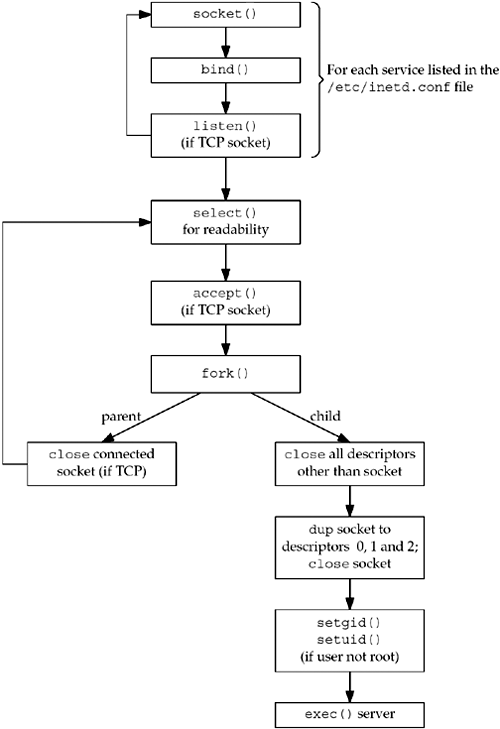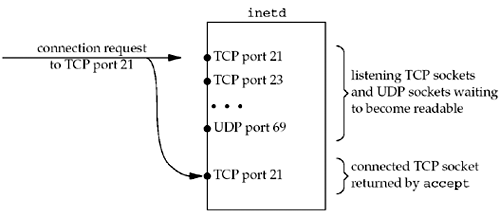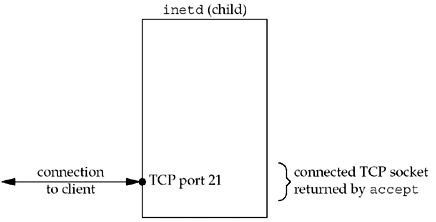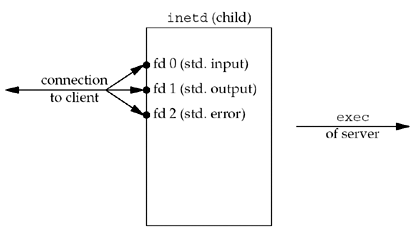Daemon Processes and the inetd Superserver
1. Introduction
Daemon是一种运行在后台且不与任何controlling terminal绑定的进程. UNIX通常会在后台运行多个daemon, 用于执行administrative task. 由于缺少controlling terminal, daemon通常由system initialization script启动; 但如果daemon由shell prompt启动, 则需要与controll terminal解绑来避免job control, terminal session management和输出到terminal的信息.
以下是启动一个daemon的方法:
- 系统启动时, 可通过system initialization script启动daemon. 这些script通常放置在
/etc或/etc/rc中. Daemon具有superuser权限. inetd作为superserver, 是系统启动时运行的一个daemon, 用于为其他service提供网络服务.inetd会一直监听网络请求(Telnet, FTP等), 收到请求后唤醒相应的server(Telnet server, FTP server等).cron作为一个系统启动时就开始运行的daemon, 用于在规定的时间运行特定程序, 被启动的程序也会以daemon的形式运行.- Daemon可通过user terminal启动, 一般用于测试或重启daemon
由于daemon没有controlling terminal, 所以需要其他方法来输出信息. 可通过syslog()将信息发送给syslogd daemon, 实现信息输出.
2. syslogd Daemon
System administrator需要处理系统中不同service产生的不同message, 例如: FTP server接收到connection的通知信息, hardware failure的错误信息, DNS server回复的统计信息. 由于不同信息的优先级不同, 处理方式不同, 需要将各个信息传递到不同的地方. Syslogd daemon就是用于处理这些信息:
- Syslogd daemon会创建一个UNIX domain socket名为
/dev/log, 监听port 514并接收service或其他host发来的信息. syslog.conf文件作为syslogd daemon的配置文件, 用于分类信息, 通常放置在/etc/syslog.conf. 接收到的日志信息通常重定向到以下地方:- system console
- 特定user
- log file
- 其他host上的syslogd daemon
- 直接抛弃.
- Syslog可以处理kernel传来的信息, 但不是直接写入
/dev/log, 而是由其他daemon(klogd)处理
进程可通过创建UNIX domain datagram socket向syslogd所绑定的pathname发送信息, 也可调用syslog()发送信息. 一些新的系统中取消了UDP socket传递信息的方式, 因为可能导致系统遭受denial-of-service attack.
3. syslog Function
由于daemon没有controlling terminal, 所以fprintf()无法输出错误信息, 需调用syslog()输出log message:
|
当application调用syslog()时, 会创建一个UNIX domain datagram, 并向syslogd daemon创建的pathname发起connect(). 以下是log message的level value:
| level | value | Description |
|---|---|---|
| LOG_EMERG | 0 | System is unusable (highest priority) |
| LOG_ALERT | 1 | Action must be taken immediately |
| LOG_CRIT | 2 | Critical conditions |
| LOG_ERR | 3 | Error conditions |
| LOG_WARNING | 4 | Warning conditions |
| LOG_NOTICE | 5 | Normal but significant condition |
| LOG_INFO | 6 | Informational |
| LOG_DEBUG | 7 | Debug-level messages (lowest priority) |
以下是log message的facility value:
| facility | Description |
|---|---|
| LOG_AUTH | Security / authorization messages |
| LOG_AUTHPRIV | Security / authorization messages (private) |
| LOG_CRON | cron daemon |
| LOG_DAEMON | System daemons |
| LOG_FTP | FTP daemon |
| LOG_KERN | Kernel messages |
| LOG_LOCAL0 | Local use |
| LOG_LOCAL1 | Local use |
| LOG_LOCAL2 | Local use |
| LOG_LOCAL3 | Local use |
| LOG_LOCAL4 | Local use |
| LOG_LOCAL5 | Local use |
| LOG_LOCAL6 | Local use |
| LOG_LOCAL7 | Local use |
| LOG_LPR | Line printer system |
| LOG_MAIL | Mail system |
| LOG_NEWS | Network news system |
| LOG_SYSLOG | Messages generated internally by syslogd |
| LOG_USER | Random user-level messages (default) |
| LOG_UUCP | UUCP system |
|
以下是openlog()中所有option value:
| options | Description |
|---|---|
| LOG_CONS | Log to console if cannot send to syslogd daemon |
| LOG_NDELAY | Do not delay open, create socket now |
| LOG_PERROR | Log to standard error as well as sending to syslogd daemon |
| LOG_PID | Log the Process ID with each message |
4. daemon_init Function
int daemon_init(const char *pname, int facility) { |
5. inetd Daemon
UNIX系统中会有多个servers等待client发送请求, 例如: FTP, Rlogin, TFTP等. 4.3BSD之前, 每个server都会在系统启动时作为daemon进程运行, 收到client请求后调用fork()处理, 但这么做存在以下缺陷:
- 每个daemon存在大量重复代码, 如创建socket, 调用
bind()绑定server port等 - 每个daemon占用process table的slot, 但绝大多数时间都处于睡眠状态
4.3BSD提出internet superserver: inetd daemon. 该daemon解决了两个问题:
- 省去每个server进程切换为daemon process的过程
- 省去每个server等待client请求, 只需要inetd一个进程等待即可
inetd的配置文件一般位于/etc/inetd.conf, 文件中每一行包含server的所有信息:
- service-name: 必须出现在
/etc/services中 - socket-type: TCP或UDP
- protocol: 必须出现在
/etc/protocols中 - wait-flag: TCP使用
nowait, UDP使用wait - login-name: 必须出现在
/etc/passwd中 - server-program: exec执行所需的pathname
- server-program-arguments: exec执行所需的arguments
以下是inetd.conf的一些例子:
ftp stream tcp nowait root /usr/bin/ftpd ftpd -1 |
以下是inetd执行的步骤:
- 启动时, 会读取
/etc/inetd.conf文件信息, 并为所以service创建socket, 每个新建的socket会被添加到select()中. - 对service-name和protocol调用
getservbyname()可获取TCP和UDP port, 并调用bind()为socket绑定wildcard IP address个port number - 对于TCP socket, 需要调用
listen()接收client请求 - inetd大部分时间处于sleep状态, 只有socket处于readable状态时,
select()才会接触阻塞 select()返回后, inetd daemon会调用fork()生成child process来处理请求. child process会关闭除socket descriptor之外所有descriptor; 调用dup2()复制descriptor 0, 1, 2; 关闭socket descriptor, 这样开启的只有descriptor 0, 1, 2; 调用getpwnam()获取login username对应的password file entry; 若username不为root, 则调用setgid()和setuid(), 将child process的UID和GID改为0.- 若为stream socket, 需要关闭socket. parent process再次调用
select()等待socket可读.
假设inetd正在运行, 收到一个FTP client请求:
inetd收到请求后, 调用fork()创建新的进程, 并与所有listening socket断开:
之后child process开始复制descriptor 0, 1, 2, 并关闭connected socket:
最后child process调用exec执行真正的server程序, server可通过descriptor 0, 1, 2与client通信. 以上场景基于nowait, 意味着接收另一个service的connection之前, inetd不需要等待一段时间再终止child process. wait flag可改变parent process的执行步骤:
- 调用
fork()返回后, parent process会保存child process的PID. 得知child process终止运行后, 运行waitpid()回收. - parent process会使用FD_CLR讲child process所使用的socket从
select()中移除, 直到child process停止运行. - 当child process终止运行时, 其parent process会受到SIGCHLD signal, parent process可通过signal handler获取child process的PID, 并恢复
select()对socket的监听.
之所以当datagram server存在连接时将socket从select()中移除, 就是为了防止inetd中select()不断检测socket的可读性: 对于TCP server, 当select()检测到socket可读时会让listening socket创建连接, 并通过connected socket处理请求; 但对于datagram socket, 由于不存在连接一说, 所以inetd调用fork()后的child process依旧使用原来的socket. 假设inetd没有关闭select()对socket可读性的监听, 且fork()执行后parent process首先执行, 则会再次检测到该socket可读, 并再次调用fork(). 为避免循环检测socket可读性, 必须在fork()前停止对socket可读性的监听; child process运行结束后向parent process发送SIGCHLD signal, 因此parent process会恢复select()对datagram socket的可读性监听.
6. daemon_inetd Function
|
相对于daemon_init(), daemon_inetd()使用inetd将进程变为daemon, 并通过设置daemon_proc flag实现error message的输出.